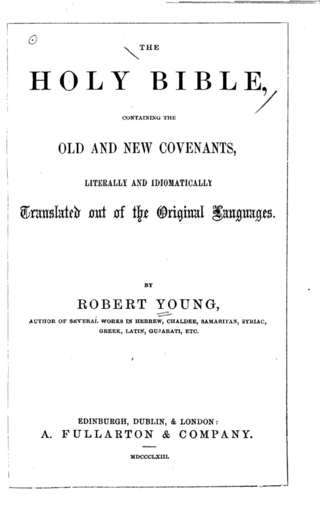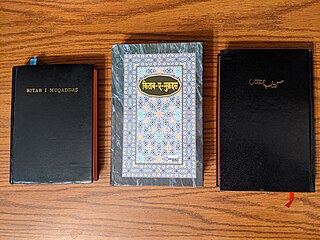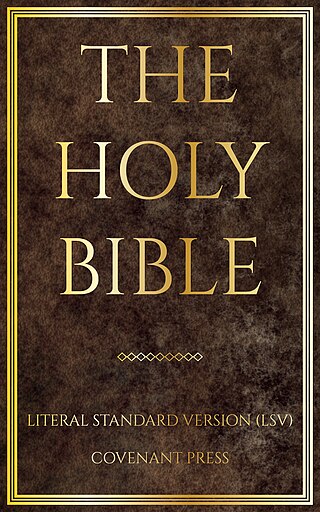
The King James Version (KJV), also the King James Bible (KJB) and the Authorized Version (AV), is an Early Modern English translation of the Christian Bible for the Church of England, which was commissioned in 1604 and published in 1611, by sponsorship of King James VI and I. The 80 books of the King James Version include 39 books of the Old Testament, 14 books of Apocrypha, and the 27 books of the New Testament.

The Septuagint, sometimes referred to as the Greek Old Testament or The Translation of the Seventy, and abbreviated as LXX, is the earliest extant Greek translation of the Hebrew Bible from the original Biblical Hebrew. The full Greek title derives from the story recorded in the Letter of Aristeas to Philocrates that "the laws of the Jews" were translated into the Greek language at the request of Ptolemy II Philadelphus by seventy-two Hebrew translators—six from each of the Twelve Tribes of Israel.

Today's New International Version (TNIV) is an English translation of the Bible which was developed by the Committee on Bible Translation (CBT). The CBT also developed the New International Version (NIV) in the 1970s. The TNIV is based on the NIV. It is explicitly Protestant like its predecessor; the deuterocanonical books are not part of this translation. The TNIV New Testament was published in March 2002. The complete Bible was published in February 2005. The rights to the text are owned by Biblica. Zondervan published the TNIV in North America. Hodder & Stoughton published the TNIV in the UK and European Union.

The New World Translation of the Holy Scriptures is a translation of the Bible published by the Watch Tower Bible and Tract Society; it is used and distributed by Jehovah's Witnesses. The New Testament portion was released first, in 1950, as the New World Translation of the Christian Greek Scriptures, with the complete New World Translation of the Bible released in 1961.

The Bible has been translated into many languages from the biblical languages of Hebrew, Aramaic, and Greek. As of November 2024 the whole Bible has been translated into 756 languages, the New Testament has been translated into an additional 1,726 languages, and smaller portions of the Bible have been translated into 1,274 other languages according to Wycliffe Global Alliance. Thus, at least some portions of the Bible have been translated into 3,756 languages.
More than 100 complete translations into English languages have been produced. Translations of Biblical books, especially passages read in the Liturgy can be traced back to the late 7th century, including translations into Old and Middle English.

The New American Standard Bible is a translation of the Bible in contemporary English. Published by the Lockman Foundation, the complete NASB was released in 1971. New revisions were published in 1995 and 2020. The NASB relies on recently published critical editions of the original Hebrew, Aramaic, and Greek texts. It is known for preferring a literal translation style that generally preserves the structure of the original language when possible, rather than an idiomatic style that attempts to match natural English usage.

The Recovery Version is a modern English translation of the Bible from the original languages, published by Living Stream Ministry, ministry of Witness Lee and Watchman Nee. It is the commonly used translation of Local Churches (affiliation).

Young's Literal Translation (YLT) is a translation of the Bible into English, published in 1862. The translation was made by Robert Young, compiler of Young's Analytical Concordance to the Bible and Concise Critical Comments on the New Testament. Young used the Textus Receptus (TR) and the Masoretic Text (MT) as the basis for his translation. He wrote in the preface to the first edition, "It has been no part of the Translator's plan to attempt to form a New Hebrew or Greek Text—he has therefore somewhat rigidly adhered to the received ones." Young produced a "Revised Version" of his translation in 1887, but he stuck with the Received Text. He wrote in the preface to the Revised Edition, "The Greek Text followed is that generally recognized as the 'Received Text,' not because it is thought perfect, but because the department of Translation is quite distinct from that of textual criticism, and few are qualified for both. If the original text be altered by a translator, the reader is left in uncertainty whether the translation given is to be considered as that of the old or of the new reading." A new Revised Edition was released ten years after Robert Young's death on October 14, 1888. The 1898 version was based on the TR, easily confirmed by the word "bathe" in Revelation 1:5 and the word "again" in Revelation 20:5. The "Publishers' Note to the Third Edition" explains, "The work has been subjected to a fresh revision, making no alteration on the principles on which the Translation proceeds, but endeavouring to make it as nearly perfect in point of accuracy on its present lines as possible." A major revision of Young's Literal Translation in contemporary English, called the Literal Standard Version, was released in 2020.
The Holy Bible in Modern English, commonly known as the Ferrar Fenton Bible, was an early translation of the Bible into English as spoken and written in the 19th and 20th centuries.
The Darby Bible refers to the Bible as translated from Hebrew and Greek by John Nelson Darby.
Green's Literal Translation or the Literal Translation of the Holy Bible (LITV) is a translation of the Bible by Jay P. Green Sr., first published in 1985. The LITV takes a literal, formal equivalence approach to translation. The Masoretic Text is used as the Hebrew basis for the Old Testament, and the Textus Receptus is used as the Greek basis for the New Testament. This translation is available in book form and is freely available online for use with the e-Sword software program. Some also refer to it as the "KJ3" or "KJV3".
There have been various debates concerning the proper family of biblical manuscripts and translation techniques that should be used to translate the Bible into other languages. Biblical translation has been employed since the first translations were made from the Hebrew Bible into Greek and Aramaic. Until the Late Middle Ages, the Western Church used the Latin Vulgate almost entirely while the Eastern Church, centered in Constantinople, mostly used the Greek Byzantine text. Beginning in the 14th century, there have been increasing numbers of vernacular translations into various languages. With the development of modern printing techniques, these increased enormously.

Jehovah is a Latinization of the Hebrew יְהֹוָהYəhōwā, one vocalization of the Tetragrammaton יהוה (YHWH), the proper name of the God of Israel in the Hebrew Bible / Old Testament. The Tetragrammaton is considered one of the seven names of God in Judaism and a form of God's name in Christianity.

The Sacred Scriptures Bethel Edition (SSBE) is a Sacred Name Bible which uses the names Yahweh and Yahshua in both the Old and New Testaments. It was produced by Jacob O. Meyer, based on the American Standard Version of 1901 and it contains over 977 pages. The Assemblies of Yahweh printed 5,500 copies of the first edition in 1981. It is also used by some members of the Sacred Name Movement.

Sacred Name Bibles are Bible translations that consistently use Hebraic forms of the God of Israel's personal name, instead of its English language translation, in both the Old and New Testaments. Some Bible versions, such as the Jerusalem Bible, employ the name Yahweh, a transliteration of the Hebrew tetragrammaton (YHWH), in the English text of the Old Testament, where traditional English versions have LORD.

Julia Evelina Smith was an American women's suffrage activist who was the first woman to translate the Bible from its original languages into English. She was also the author of the book Abby Smith and Her Cows, which told the story of her and her sister Abby Hadassah Smith's tax resistance struggle in the suffrage cause while the two were living at Kimberly Mansion in Connecticut.

The modern Hindi and Urdu standards are highly mutually intelligible in colloquial form, but use different scripts when written, and have lesser mutually intelligibility in literary forms. The history of Bible translations into Hindi and Urdu is closely linked, with the early translators of the Hindustani language simply producing the same version with different scripts: Devanagari and Nastaliq, as well as Roman.

The Kingdom Interlinear Translation of the Greek Scriptures is an interlinear translation of the New Testament, published by the Watchtower Bible and Tract Society of New York, Inc. and translated by the New World Bible Translation Committee. The first edition was released at an international convention of Jehovah's Witnesses in 1969. As of the 1985 revision, 800,000 copies were produced.

The Literal Standard Version (LSV) is a Modern English translation of the Bible with a number of distinctive features. It describes itself as the most literal translation of the Bible into the modern English language. The first edition was published on February 2, 2020.














